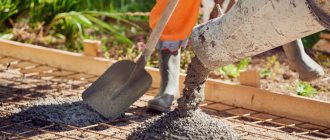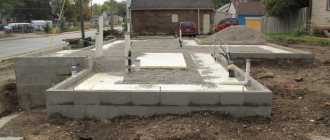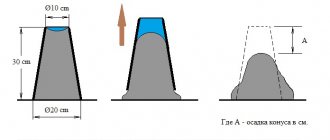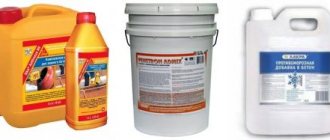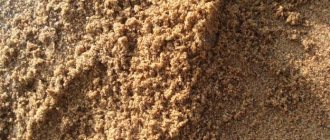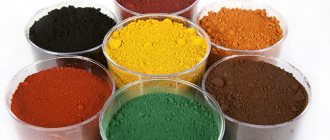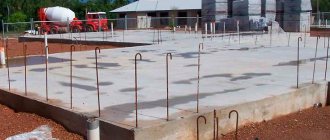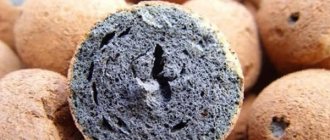When constructing buildings and carrying out activities to screed heated floor coverings, a dense and movable material is used - concrete. To improve its performance characteristics and increase resistance to temperature changes after hardening, a special plasticizer (additive) is added to the mixture at the preparation stage.
A plasticizing additive is a special composition that modifies concrete and prevents the formation of cracks. After its introduction, fluidity increases, the mixture fully fills voids and does not form air bubbles.
Application and purpose of plasticizers
Plasticizers for concrete are used at different stages of construction, so let’s figure out why they are needed and what types they are. Such additives make it possible to increase the strength of mixtures by 30%, reduce its consumption by 5%, and water consumption by a quarter.
Other positive qualities include the following:
- increasing the time of use of the finished solution;
- improving the quality of the material;
- increase in adhesive properties;
- ease of laying the mixture;
- frost resistance.
Types of plasticizers
For the construction of monolithic structures, different types of concrete are used, which appeared thanks to the use of plasticizers. Supplements are divided into types, have different ways of working, amount of use and end result.
The main types of plasticizers for concrete are:
- Hydrophilic - reacting with water, which is found in all concrete mixtures. As a result of the chemical process, an astringent and fluid composition is formed. Once in the concrete solution, the plasticizer binds water molecules, which turns into a viscous mixture that interacts with cement, crushed stone and sand.
- Hydrophobic and hydrophobizing - during the hardening process, they push water out of the composition. The operating principle is based on saturating the mixture with microscopic air cavities, which in turn increases the insulating properties of the finished structure, removes excess moisture, and reduces the possibility of freezing of the poured solution.
Additives have different principles of application, contain additional components, and are accordingly divided into two types: dry and liquid plasticizers for concrete. Dry ones are presented in powder form. They can be used by adding to a dry mixture, or diluted with water and mixed with the main mass.
The liquid plasticizer has a high concentration and occupies no more than 1% of the total volume of the finished solution. One of the main features of this type of additive is that it replaces some of the water, which has a positive effect on hydration during the hardening process.
By origin, plasticizing mixtures are of three types:
- Organic – contains natural ingredients. They have a high concentration and are able to react quickly.
- Inorganic - made on the basis of special compounds that are suitable for organizing formaldehyde and other compounds.
- Organomineral - contain natural components and other types of minerals.
Plasticizers for concrete. Operating principle and types
In short, a plasticizer is an additive to concrete that increases the fluidity of the cement mortar and does not require an increase in the amount of water in the solution.
What does this give? Answer: a lot.
If you do not understand the intricacies of mixing the mortar and do not know about the water-cement ratio, strength gain, workability and other indicators of concrete mixtures, then you can familiarize yourself with this in these articles:
What is concrete
Types of concrete
Additives for concrete
They will help you understand the processes occurring in the mortar and ready-made concrete; it will also be easier to understand the principle of operation of plasticizing additives and what they affect in mixtures when added.
You may have heard or personally observed a person mixing cement mortar adding soap to it. When asked why he was doing this, they received the answer that the concrete itself would be better this way and it would be easier to lay it. This method actually exists and is often used in “handicraft” conditions. This is the simplest example of a plasticizing additive, but quite controversial, because soap is a product of another industry and is not intended for such purposes. There is no clear dosage, instructions for preparation, and the soap components themselves are very different. For clarity, you can visit forums where a similar issue is discussed and you will see a lot of recipes and debates around this topic. The editors do not recommend using this method and cited it as a simple example on the basis of which the work of plasticizers for concrete mixtures will be analyzed.
First, let's figure out what soap is? The answer will look something like this: Soap is a solid or, less commonly, liquid product containing surfactants (Wikipedia). We are interested in precisely these surfactants (hereinafter referred to as surfactants) - chemical compounds that, concentrating at the interface of thermodynamic phases, cause a decrease in surface tension (Wikipedia). Perhaps this explanation will be difficult to understand, but in fact it is important for us to understand a couple of points, namely the fact that surface tension is reduced by these substances and concentration at the boundary of thermodynamic phases. Those. soap, when added to a cement mortar, reduces the surface tension of water in the structure of the mortar and makes it possible to strengthen the connection of solid filler particles with binders, this occurs by increasing the wettability of the surface of the particles of binder components. Such processes increase the fluidity of concrete dough and its plasticity, but do not require additional addition of water to the solution. Which, in turn, makes it possible not to increase the water-cement ratio, or even reduce this indicator. The water-cement ratio directly affects the strength of the future concrete, but also affects the workability when laying the mortar into a concrete structure.
As you can see, such an additive, using ordinary soap as an example, can influence many important factors in working with concrete solutions.
If we consider soap from a chemical point of view, it can be classified as an alkaline substance. This also includes other types of concrete plasticizers. But as said earlier, soap is a product of a different industry and is intended for other purposes, although it reduces tension and strengthens bonds, it also has many extraneous elements that can negate all attempts to improve the cement mix. There are also no clear instructions for adding. It is better to use specialized supplements that have calculated doses and are described in the instructions.
Using the example of soap, we found out that plasticizers for concrete are special additives designed to increase the fluidity of the mixed cement mortar, allowing to reduce the water-cement ratio of the mortar. An increase in fluidity increases the workability of the mixture, reduces the amount of cement consumed, and improves the fillability of the formwork with the solution. Increasing the cohesion of the mortar components also prevents the mortar from separating during installation.
Existing plasticizing additives can be divided into 3 categories:
plasticizers;
superplasticizers;
hyperplasticizers.
According to the form of production, they are divided into two types:
in liquid form;
in the form of dry mixtures.
According to their chemical composition, plasticizers are divided into three main groups:
Lignosulfonates (LST) are a by-product of wood processing and belong to anionic surfactants;
silicone polymers KOS (organosilicon compounds);
polycarboxylate and polyacrylate compounds.
Although there are not many categories and types, everything is complicated by the huge number of types of concrete and their use in construction. Some supplements have side effects, both positive and negative, and may have different durations of action. Sometimes they are mixed to improve certain properties or neutralize some of the effects of the components.
To better understand the plasticizers used, you need to understand the mechanism of their operation and how the expected effect of liquefying the solution is achieved.
Considering the example with soap, we mentioned surfactants and their work at the interface of thermodynamic phases, causing a decrease in surface tension. A phase is understood as a collection of many parts of a system with the same composition and properties, separated from the rest of the system by an interface. Those. In ordinary cement mortar there are: cement, sand, water. And each solid in this mixture represents a separate phase, regardless of its distribution in the system. As is known, the smaller the particle size of a component, the higher its total specific surface area, and the higher the total specific surface area, the better the chemical reactions. If the sand is quite coarse, then the cement is usually quite fine and dusty. After mixing sand and cement, add water. However, water has significant surface tension (i.e., significant adhesion forces act between water molecules located in its surface layer at the phase boundary), which prevents it from spreading over the surface and wetting of the cement occurs incompletely and heterogeneously. When a surfactant is added to water, the surface tension of the water decreases and the process of wetting the surface of solids in the mixture occurs much better and faster. Another important point is the neutralization of opposite charges and the disintegration of crumpled cement into smaller fractions, which in turn increases the specific surface area of the cement participating in the chemical reaction. These changes greatly increase the viscosity of the solution for the same amount of water.
Surfactants can affect the rate of cement hydration, but the chemical compositions of the solution and surfactant play an important role here, so this point must be considered for each additive and solution separately.
The difference in fluidity of a solution with the addition of a surfactant can be compared in the table:
The influence of plasticizing additives LST, MLS (modified lignosulfonate) and KhDSK-1 (lignosulfonate modified by NaOH) on the properties of the concrete mixture.
Superplasticizers (hereinafter referred to as SP) liquefy solutions much more strongly than LST additives; another important point is that they operate throughout the entire test period and do not reduce the strength characteristics of concrete.
All used SPs can be divided according to their chemical composition:
- based on sulfonated melamine-formaldehyde resin;
- based on polycondensation products of naphthalene sulfonic acid and formaldehyde;
- this includes polycondensation products of hydroxycarboxylic acids;
- modified lignosulfonates.
Below is a list of widely used joint ventures in the table:
These SPs differ from the previously discussed LST plasticizers with surfactants in the constancy of their chemical composition; they are products of organic synthesis—polymers.
SPs based on melamine (MF) and naphthalene (NF) are quite similar in terms of their mechanism of action and effectiveness. The key difference is the duration of the plasticization effect and the cost of raw materials.
The principle of operation of the joint venture is the operation of surfactants (they are also present here, as in LST plasticizers), which form a finely dispersed fraction of fillers of monomolecular adsorption shells on the surface of cement particles (to put it simply, a thin film is formed on the cement particles and filler, repelling these particles from each other), reducing internal friction in the concrete mixture. Surfactants also separate stuck together cement particles and increase its specific surface area. This has a positive effect on the intensity of the hydration process and the formation of the cement stone structure.
SP affects almost all quality indicators of concrete. They increase water resistance and frost resistance, and reduce shrinkage.
But they also have disadvantages. First of all, they are quite expensive and the addition of the SP additive to concrete solutions, in volumes of 0.5-1% by weight of cement, seriously affects the final cost of the product. In addition, for most joint ventures, the plasticization period for the solution is about 30-40 minutes. This time interval greatly limits their use.
Operating principle of superplasticizers
The mechanism of action of SP refers to the theoretical part, due to the lack of a complete understanding of the processes occurring inside the solution. However, some points are still clear:
- SP molecules reduce surface tension at the liquid-solid interface, in contrast to LST plasticizers with surfactants, which reduce surface tension at the gas-liquid interface. This difference explains the reduced air entrainment in the concrete mixture with the introduced SP;
- SP molecules have a dispersing effect on the particles of the binder (i.e., the repulsive effect of cement particles and fillers). As a result, the proportion of fine fractions doubles, which increases the astringent properties of cement;
- the action time of SP is significantly shorter than that of LST additives with surfactants, this is due to the structure of SP molecules and their molecular weight;
- many SPs have less effect on the rate of cement hydration than LST additives with surfactants.
As a result, during the hydration process, calcium hydroxide accumulates in the system, which interacts with SP molecules and removes them from the surface of cement grains.
The mechanism of action of SP on the components of cement mortar is dominated by the effects of electrostatic repulsion of cement particles. But the molecular formulas of SP have a linear structure. Hyperplasticizers (hereinafter referred to as GP) have a lesser electrostatic repulsive effect, but at the same time they have a two- and three-dimensional formula that allows them to create a steric or spatial effect, which compensates for the lag in electrostatic indicators. GP molecules, with spatial connections, create a voluminous protective shell around solid phase particles, prevent particles from sticking together and promote their mutual repulsion.
This volumetric shape of molecules creates twice as much repulsive force as that of SP and three times as much as LST.
Thanks to this structure, GP is more effective than other types of plasticizers, has lower dosages, and does not depend as much on the composition of cement as SP.
Plasticizing additives also serve as the basis for other additives and are used in various complex additives. For example:
Water-reducing additives for concrete
Material characteristics
Plasticizers have a low degree of volatility and are highly compatible with materials. The additive has no odor, the chemical composition does not affect the color of the material. This applies only to high quality raw materials, which do not release alkali during the mixing process.
Characteristics of certain types of plasticizers:
- can help improve fire resistance;
- resistance to ultraviolet radiation;
- improving heat resistance.
Some of the products may be highly specialized, but each of them increases the strength properties.
Popular Supplement Brands
Plasticizers reduce water demand without changing the consistency of the mixture, while superplasticizers can significantly reduce the water content.
This category includes one of the popular brands of plasticizer for concrete, C3. The additive is produced using the method of organic synthesis of cellulose compounds. The result is surfactants that increase the strength of the concrete solution.
plasticizer for concrete C3
The Sika brand concrete plasticizer is a low-cost material intended for the production of concrete and reinforced concrete products and other structures. The additive in this series is highly compatible with aggregates and various types of cement. Capable of reducing water requirements by up to 40%, resulting in a strong and durable concrete matrix.
One of the popular additives for accelerating the strength gain of concrete, increasing its frost resistance and water resistance is the TechnoNIKOL plasticizer. It is produced in liquid form and is used for all types of foundations, blind areas, door and window slopes, and is used when installing heated floors.
plasticizer TechnoNIKOL
Why do you need a plasticizer?
Plasticizing additives are organic or inorganic substances that, when added to concrete or mortar mixtures, significantly increase its mobility.
The mobility of the mixture is measured using an Abrams cone and is designated by the letter P with numbers from 1 to 5. This device is exactly 100 years old.
It is a hollow metal cone with a diameter of 20 cm at the bottom, 10 cm at the top and a height of 30 cm, into which a concrete or mortar mixture is compacted with a special rod and, when removed, the settlement of this cone is measured in cm.
Based on the settlement indicators, there is a gradation of the mixture mobility scale, or there is another term - workability.
The P1 value is assigned when the cone draft is 1-4 cm, and P5 is more than 21 cm. Why am I going into such detail with this technical term, and here’s why - if there is a low mobility indicator, the mixture cannot be supplied through the hoses of a concrete truck and it will not be possible to fill complexly reinforced structures
It should be noted that when adding plasticizers, there is regulatory documentation that controls the loss of concrete strength from their use.
Namely, no more than 5% loss of strength when adding a plasticizer, which is determined in laboratory conditions by the strength of concrete or mortar cubes (100x100x100 cm) after 28 days of hardening at a temperature of (20±2) C and a relative humidity of at least 95%.
Material consumption
The consumption of plasticizer for concrete depends on its release form. For example, a liquid additive must be measured in a ratio of 0.5-1 liter per 100 kilograms of cement used for the construction of walls, floor screeds, and ceilings. 1-2 liters are needed per 100 kilograms of cement for self-compacting concrete, used for pouring foundations and forms for complex reinforced concrete load-bearing structures.
Dry plasticizer is presented in the form of a powder, which must be added to the source material, after diluting it with water. The solution should have a concentration of 15-35%.
To determine how much plasticizer to add to concrete, you must use the dosage indicated on the packaging, since manufacturers may indicate different proportions of additive use.
To finally determine the concentration of the plasticizing additive, it is necessary to find out how much cement will be used to prepare the mixture. Household concrete mixers are designed for 10-15 kg of cement, so it is more convenient to use a standard container, for example, a liter jar. If the packaging indicates from 0.5 to 1%, the optimal proportion of plasticizer for concrete will be approximately 0.7%.
Application of plasticizers
We can say that additives were invented to make construction work easier. For example, a large amount of concrete can be prepared in a concrete mixer without it hardening quickly or forming lumps.
In addition, they allow you to use a small amount of water. In short, plasticizers are widely used during large-scale construction projects.
Now experts are actively using plasticizer in concrete to create monolithic blocks, fine-grained and lightweight slabs, and various structures. “Transformed” concrete is used not only to strengthen a building, many useful products are made from it (blocks, borders, fountains, slabs, flowerpots, pillars, and so on).
Manufacturers offer plasticizers in liquid or dry form. In any case, they must be diluted with water. The less water in the mixture, the stronger it will be in the end. The minimum ratio of cement and water is 25 liters per 100 kg of dry mixture. The optimal ratio is considered to be 45 liters per 100 kg of cement.
Are there certain proportions of plasticizer for concrete ? In fact, each plasticizer has its own purpose and indicated dosage on each package. Everything will depend on the concentration of the finished mixture at the outlet. On average, this amount will be 1 kg of plasticizer per 100 kg of cement.
Before adding the plasticizer to the mixing machine, it is diluted in water (approximately 100 g per 10 liters of water). Next, the mixing process is carried out and the mixture is ready for use.
Is it possible to create a plasticizer for concrete with your own hands ? It turns out, yes, back in Soviet times, ordinary laundry detergent or dishwashing detergent were used as additives.
What has always been difficult is calculating exactly how much to add to the concrete. Typically, detergent samples were used that produced little foam. White, visible marks on the bricks of the newly built house indicated that detergent had been added to the cement mixture.
The approximate ratio of additives will be as follows:
- shampoo or liquid soap is added to cement at the rate of 200 g per 50 kg; - washing powder is added to cement at the rate of 100-150 g per 50 kg; — slaked lime is added in a ratio of 20% of the total mass of cement powder; - PVA glue is mixed into one bucket of solution in the amount of 200 g.
The main task of any additive is to increase the fluidity of the concrete mixture, in simple words to “revive” it. Before you buy a plasticizer for concrete , you should decide exactly for what purpose it is needed. The construction market offers proven manufacturers such as Cemmix, Cika, Den Braven.
Interestingly, to make concrete more porous, they resort to using materials such as perlite, expanded clay and many others. Thanks to them, thermal insulation properties and resistance to external negative factors are increased.
In addition to plasticizers, accelerators are also used - these are the so-called smaller brothers of the plasticizer. For example, to accelerate hardening or, conversely, slow it down. Additives to enhance frost resistance and absorb more air.
Making your own plasticizer
To replace the plasticizer for concrete, you can prepare it yourself.
One of the easiest ways is to use powder, liquid soap or shampoo. When the concrete mixture is mixed, it produces foam. The calculation is made according to the weight of the cement; 1 bag will take approximately 200 grams of powder or 200 milliliters of any substance.
When plastering surfaces, you can use slaked lime in proportions of 200 grams per 1 kilogram of concrete. The solution will become quite elastic and its ability to stick together will increase.
When using soapy substances, efflorescence may appear on the dried surface, which is a disadvantage of using home remedies. But if you add glue to the mixture, you can avoid such problems.
The glue will not spoil the solution, and cracks will not appear when it dries. The product should be used per 10 liters of solution - 200 milligrams of glue.
A homemade plasticizer for concrete has a low cost, but one of its main disadvantages is the appearance of a large amount of foam. Therefore, in this case it is better to use components with reduced foaming or wait until the bubbles settle.
Advantages of using a plasticizer for concrete
The use of plasticizing additives has many positive aspects, among which are:
- High quality and optimal price. With the use of a plasticizer, cement consumption is reduced by approximately 25%, which makes it possible to reduce costs.
- Increasing the life time of the mixture by 4-5 hours if long-term transportation is necessary. In this way, you can save time that could have been spent constantly stirring the finished solution.
- Increase in composition strength by approximately 20%. In practice, it has been proven that work with the base can be started earlier; there is no need to wait 28 days for the concrete to cure.
- Increased drying time. This advantage will make it possible to pour the foundation in several stages without knocking down the top layer of concrete. This will only increase the strength and prevent cracks from appearing on the surface.
- Possibility to use special equipment. When constructing objects, low-elasticity mortar must be lifted to the floors manually. With the use of a plasticizer, its elasticity increases, which makes it possible to attract the gas pump to work.
- When laying the mixture, there is no need to use a vibration compactor. This tool is designed to mix the solution and remove excess air bubbles. Due to the fact that the concrete mixture becomes mobile, there is no need to use a vibrating compactor.
- Maximum filling of voids. Thick concrete does not easily fall through a large amount of reinforcement; with the addition of a plasticizing agent, this problem will disappear. Thanks to this, the base becomes more durable and will not crack under heavy load.
- Increased waterproofing. The solution becomes thicker, and at sub-zero temperatures the risk of concrete rupture is reduced.
In what quantities is plasticizer added to the cement composition for screed?
Manufacturers of plasticizing components indicate on the packaging the required dosage to ensure the achievement of the required mechanical properties of the concrete mixture.
The amount of plasticizer introduced is determined by calculation, taking into account the total volume of the solution and the type of additives:
- the concentration of plasticizing additives in the liquid consistency is 1–1.5%, depending on the brand of material. The liquid plasticizer is pre-mixed with water and added during the preparation of the composition at the rate of 0.5–0.75 liters per bag of cement;
- Adding dry ingredients is done in the same way, with the exception of the preparatory mixing operation. The powdery component is mixed with water in a ratio of 1:2, followed by mixing with cement.
Using a construction mixer greatly simplifies the mixing process. The finished concrete settles for half an hour, after which it can be used.
When preparing a concrete solution with the addition of plasticizers, it is especially important to adhere to the recommendations of the plasticizer manufacturer
